
AI-powered app builders have taken the app development world by storm, as the traditional way of manually coding apps is intensive and generally takes a lot of time.

While AI app builders offer speed, accessibility, and developer control, their evolution raises a new question: Which AI app builder should I use for my project?
In this article, we will explore the top three AI app builders, their pros and cons, and why you should choose one over the other in various situations.
For the contenders, we have:
At the end of the article, you should be able to make an informed decision on which of them you should go for and why.
The Replay is a weekly newsletter for dev and engineering leaders.
Delivered once a week, it's your curated guide to the most important conversations around frontend dev, emerging AI tools, and the state of modern software.
We will evaluate these three tools via the following criteria:
Below is a summary of the evaluation results:
| Metric | Firebase Studio | Lovable | Replit |
|---|---|---|---|
| Ease of Use (UI, onboarding) | The UI is intuitive but not the cleanest | It comes with a clean interface. Starting out is very easy. Lovable seems to be outstanding here 🏆 | It has a nice interface |
| Design Control and Theming | Supports granular customization of the color scheme. It also does a good job at asymmetric designs. Dark mode integration is a breeze. Firebase Studio wins here 🏆 | Struggles with asymmetric designs. Dark mode works well | Performs well with dark mode integration and also performs well with asymmetric design |
| Code Access and Exportability | You can view and edit your code on Firebase Studio | You cannot edit code if you are on Lovable free tier | Code can be edited even on the free tier. Replit wins here 🏆 |
| Backend and Data Integration | You need to have a paid plan to link your app backend | Lovable easily supports backend integration | Replit is the winner here. Backend can be done without stepping out of Replit 🏆 |
| Collaboration, GitHub | Firebase Studio doesn’t support collaboration | Lovable lets you connect your GitHub to Lovable and sync your project 2-way with GitHub to collaborate at source. Lovable wins here 🏆 | You can send invites for others to join the workspace and collaborate. Replit shines here as it uses major prompt changes as Git commit messages |
Before we get started with our evaluation of the three tools, we’ll need to get set up with each.
Let’s start with Firebase:
Firebase only requires you to sign in with your Google account.
Thereafter, you can give it your prompt.
It allows the addition of images for optimal prompt efficiency:
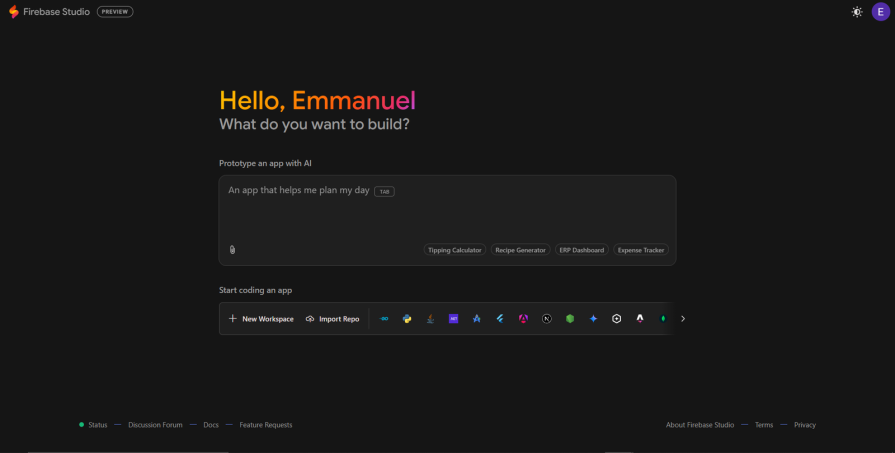
Lovable comes with a clean and minimalistic home interface.
It is straightforward to sign in on Lovable; there is a provision to sign in with your Google account.
Apart from the text prompt, you can also add images to help with your prompt:
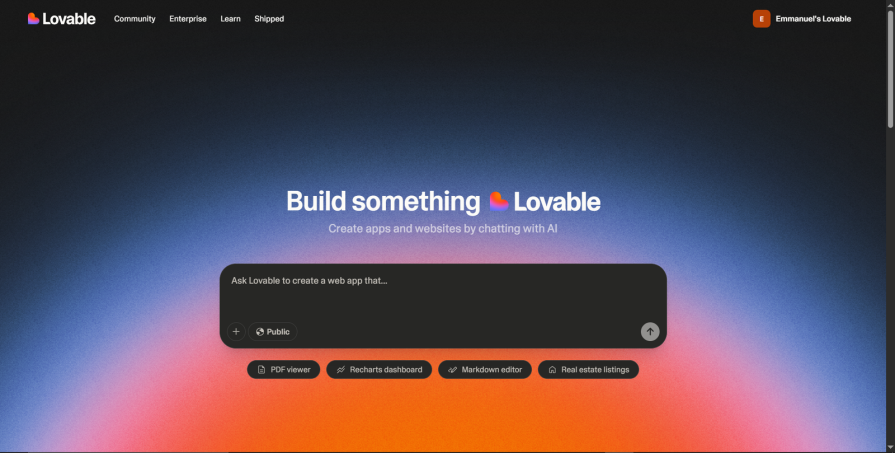
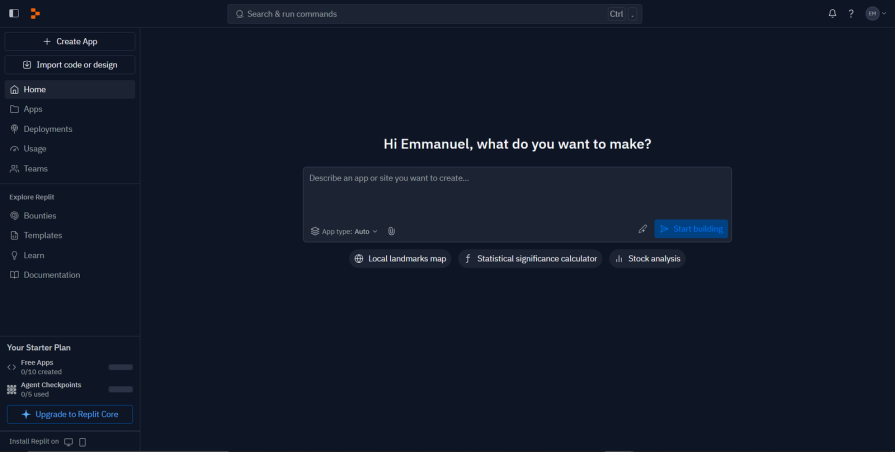
On the Replit prompt page, there are options to choose between the following tech stacks:
Replit offers the creation of 10 free apps, after which you must start paying.
UI wise, I think Lovable offers a greater ease of use with its minimalistic UI.
In this section, we will evaluate support for:
Our test prompt will be: “Create a food ordering app; this app should include a modern–looking user interface, order, and checkout pages.”
Firebase Studio produced an app blueprint, but there is a problem.
It added an AI stack that I do not need in this app:
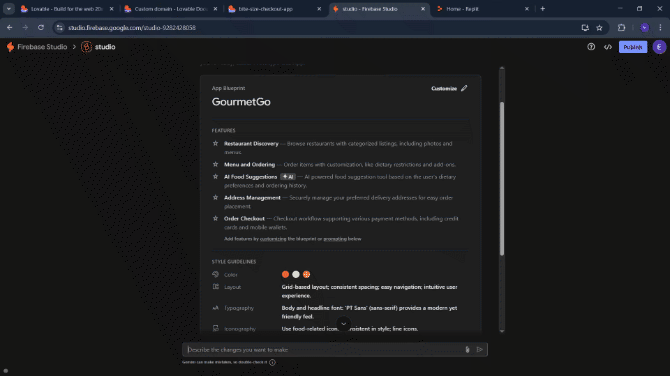
Since I do not need the AI feature, I told it “I don’t need the AI feature.”
I then clicked the “Prototype this app” button, which created the prompt:
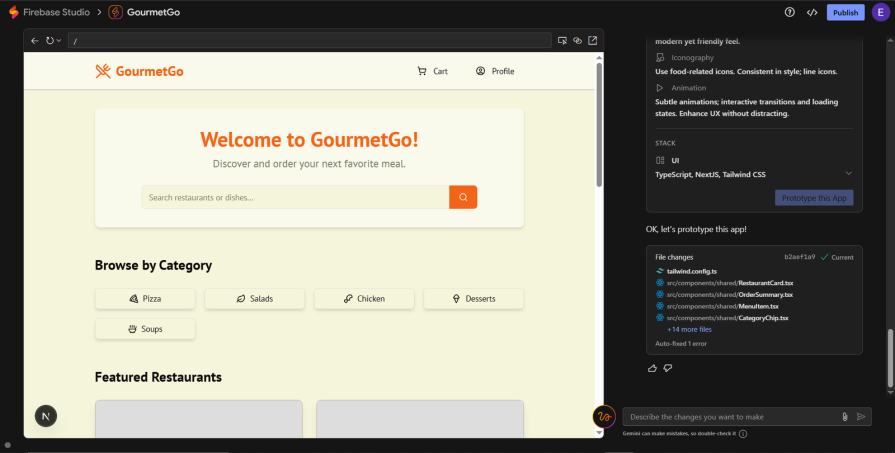
I first checked it for dark mode capability.
I gave it the prompt, “Add support for dark mode in the app and include a way to toggle on and off dark mode.”:
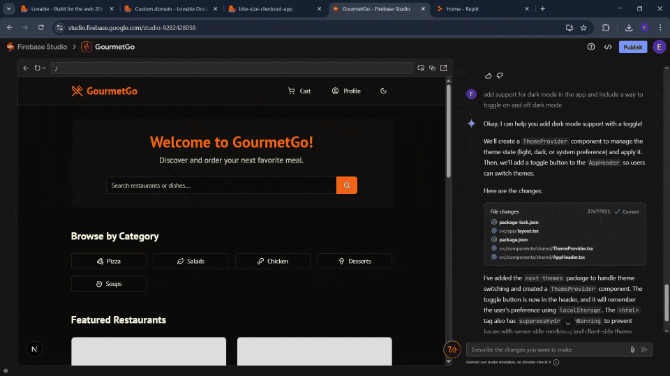
It does a great job in dark mode. I then checked it for mobile responsiveness:
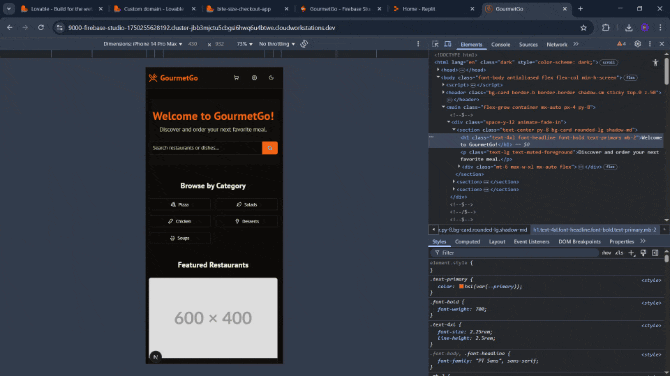
It is responsive on mobile, but I will recheck for mobile responsiveness when I change the design layout.
Let’s play around with the design layout.
I gave Firebase Studio the following prompt: “Change the design layout to an asymmetrical layout.”
It still looks good on larger screens:
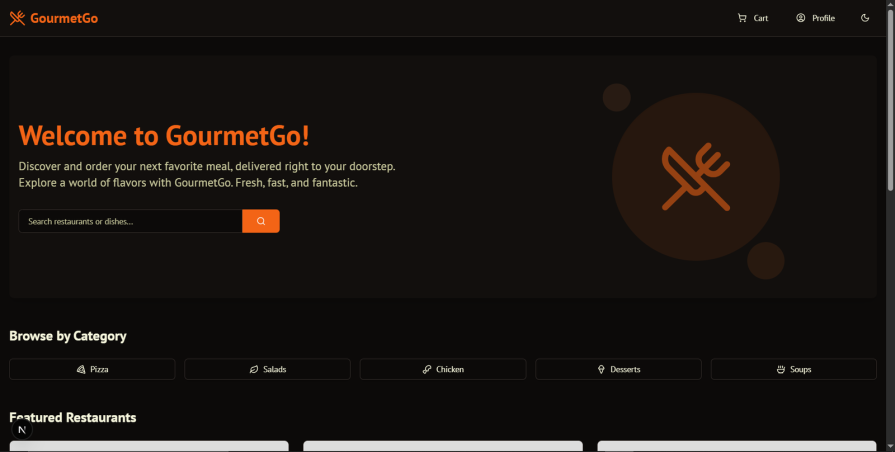
Let’s see how it looks on mobile:

Looking good!
I gave Lovable our test prompt, and it gave me the design below.
Let’s work with it:
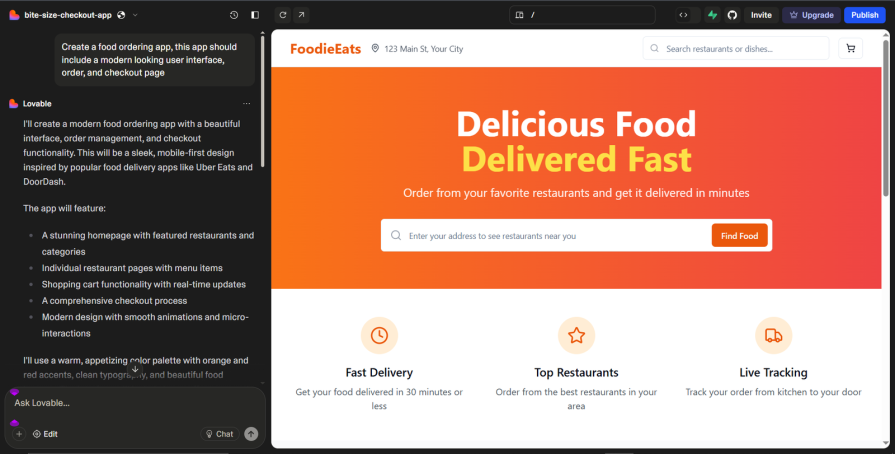
I will now prompt it to add support for dark mode.
I will be using the same prompt we used earlier: “Add support for dark mode in the app and include a way to toggle on and off dark mode”:
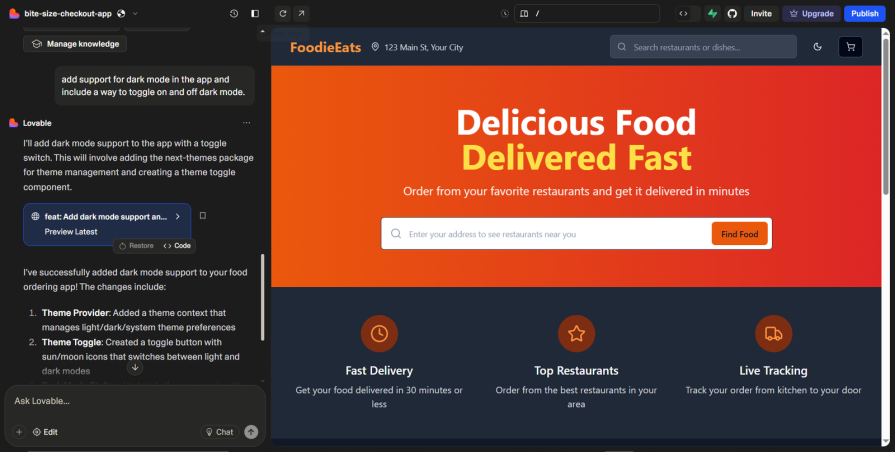
On the normal grid design layout that Lovable generates, the design is responsive right out of the box.
Let’s prompt it to change the design layout to asymmetrical and see if it can still hold up its responsiveness.
The following prompt will do: “Change the design layout to an asymmetrical layout.”
After I changed the layout from grid to asymmetric, the design was struggling with responsiveness on mobile:
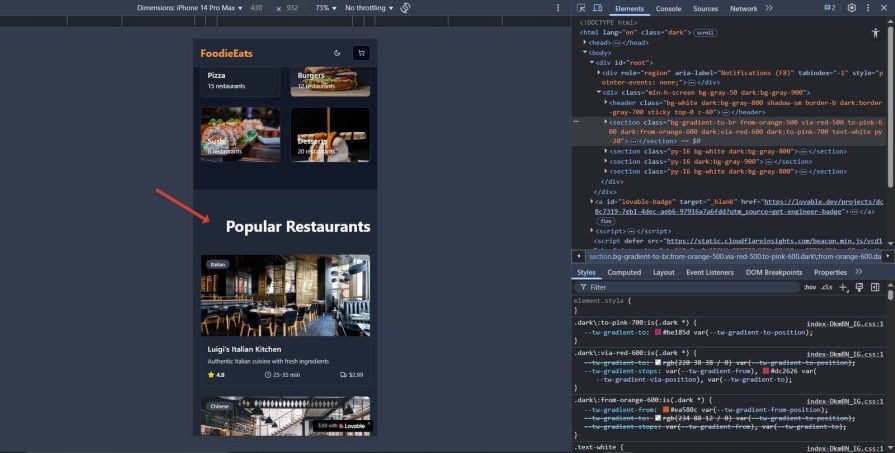
After running the test prompt, Replit generates a plan for your app. You’ll first have to approve this plan before moving forward. The app plan contains features for the initial version of your app, so you can add or take out some features.
Then it will show you a UI preview of your app before it generates code for it:
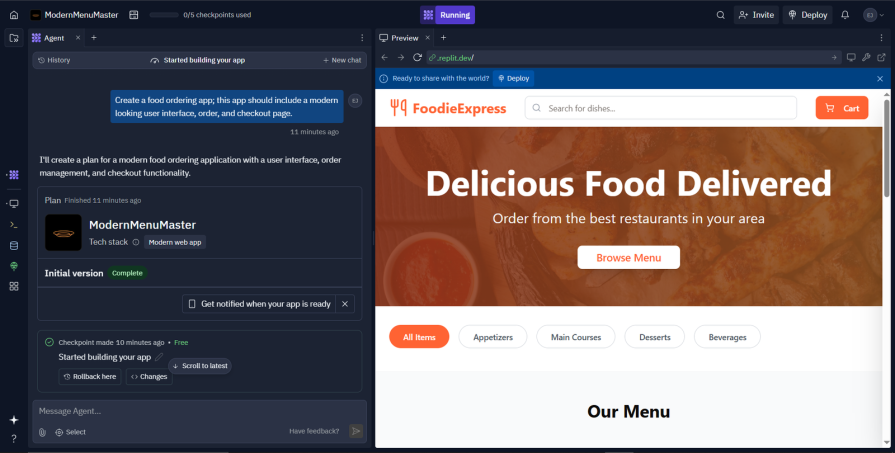
Here, we will still follow the path we took on the other tools by asking Replit to add dark mode capability to the app, check responsiveness, and change the design layout to asymmetrical
Let’s first prompt it to generate dark mode for our app.
I gave it the prompt “Add support for dark mode in the app and include a way to toggle on and off dark mode.”
It does indeed support dark mode:
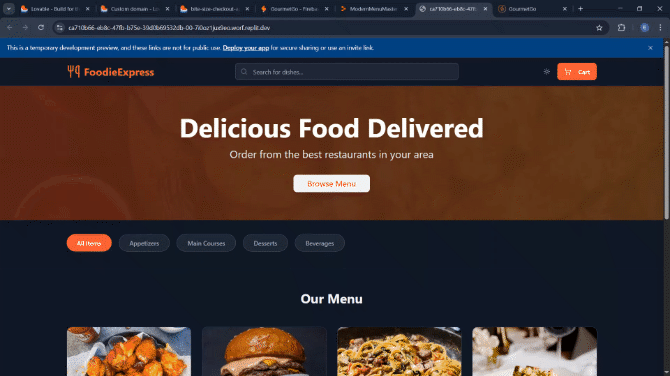
For responsiveness, Replit generates responsive code out of the box, so there is no need to prompt it to make the app responsive.
On asymmetrical design layout, Replit struggles with responsiveness, as we will later discover when we discuss layout.
I tested the responsiveness on an iPhone 14 Pro Max for mobile, Surface Duo for tablet devices, and full for desktops and laptops. It passed the sniff test on all of these.
Replit, like other tools, creates a grid design layout by default. Let’s check how it does with an asymmetrical design layout.
I will prompt it with the following prompt: “Change the design layout to an asymmetrical layout.”
Replit did its magic by changing our layout from grid to asymmetrical:
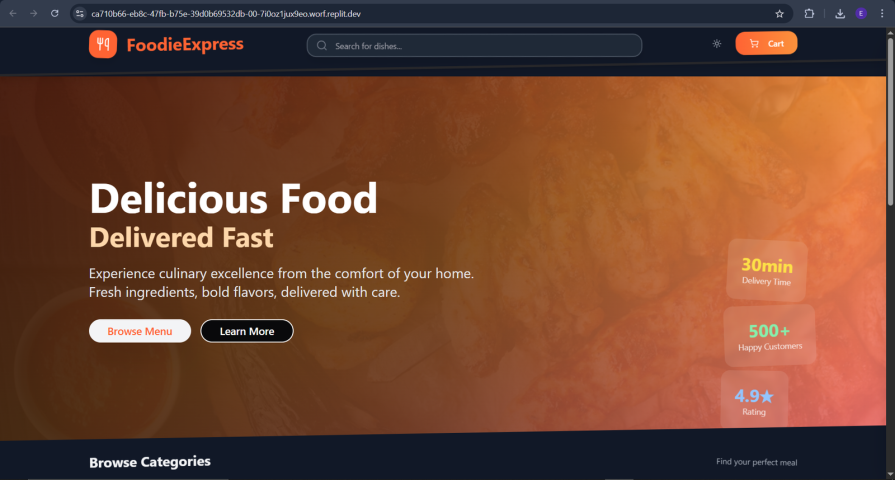
And it still looks good on mobile:
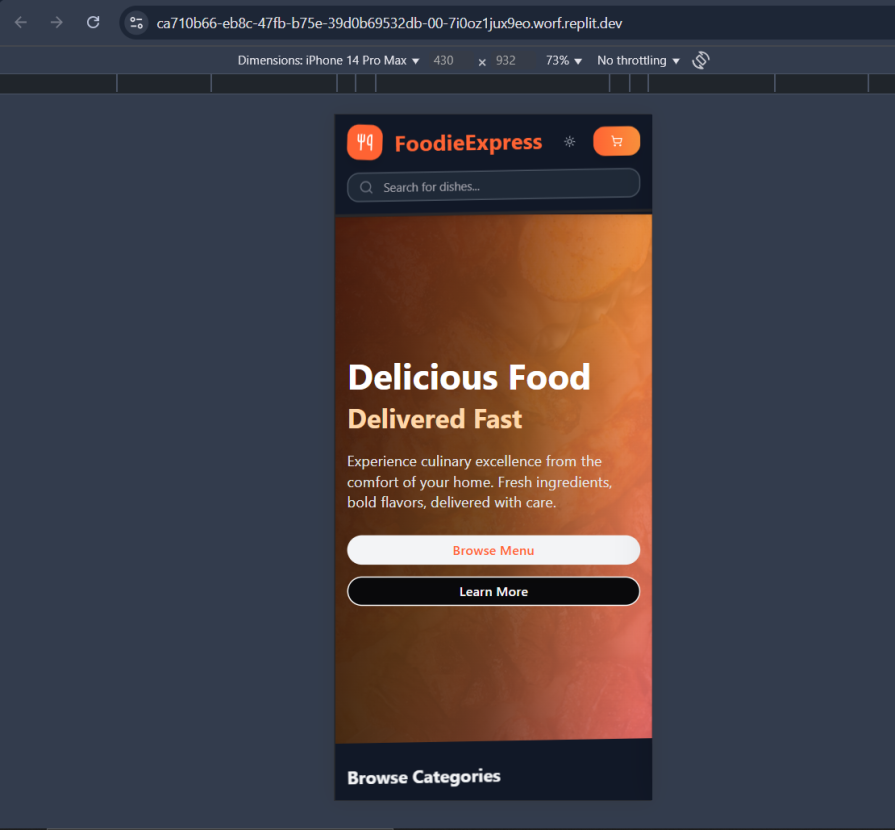
Replit wins here with its modern-looking design and perfect responsiveness on mobile.
In this section, I will look at how easy it is to take your projects outside these platforms.
One of the advantages of Firebase Studio is that you can view and edit your code on the cloud tool.
Coming from a software engineering background, the code editor feels familiar, as it uses VSCode Web, a lighter version of the popular code editor that runs in web browsers.
Let’s get in and edit the app to show our four food images from Cloudinary.
Since Firebase Studio only generates blank images, I will get into the code and edit images on the homepage to display nice food images I generated from lummi.ai
I will get into the next.config.ts file to configure Next.js to accept our Cloudinary link.
Inside the next.config.ts file, I will change the image property to use the code below:
images: {
domains: ['res.cloudinary.com'], // I edited here
},
Then I edited the page.tsx file and changed the imageUrl to use the following images:
https://res.cloudinary.com/ddxzftn21/image/upload/v1750166591/Gourmet_Table_Spread_mypakb.jpg https://res.cloudinary.com/ddxzftn21/image/upload/v1750166591/Elegant_Dining_Spread_xhquqs.jpg https://res.cloudinary.com/ddxzftn21/image/upload/v1750166591/Grilled_Meats_and_Vegetables_Spread_laluww.jpg https://res.cloudinary.com/ddxzftn21/image/upload/v1750166590/Gourmet_Fried_Food_on_Salad_efdkwi.jpg
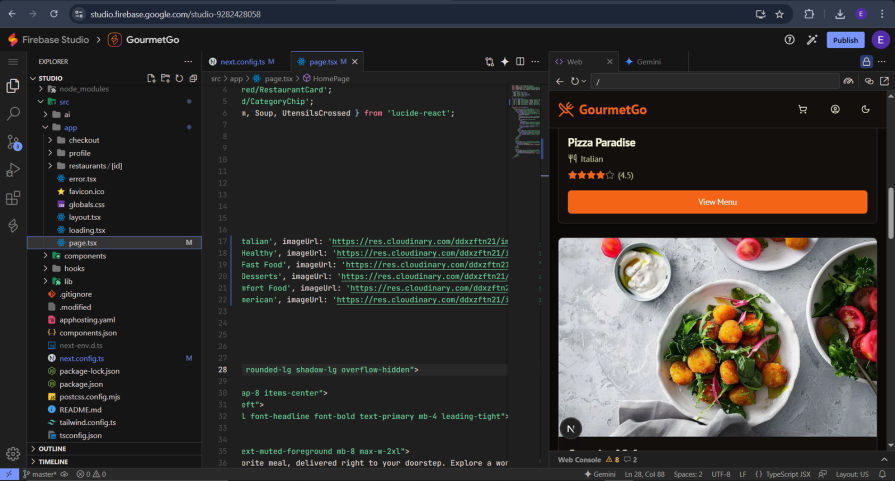
I now have the app running using images from Cloudinary.
To publish the app, you must set up and link a Google Cloud account. You can preview the app here.
You cannot edit the code if you are on a free tier on Lovable:
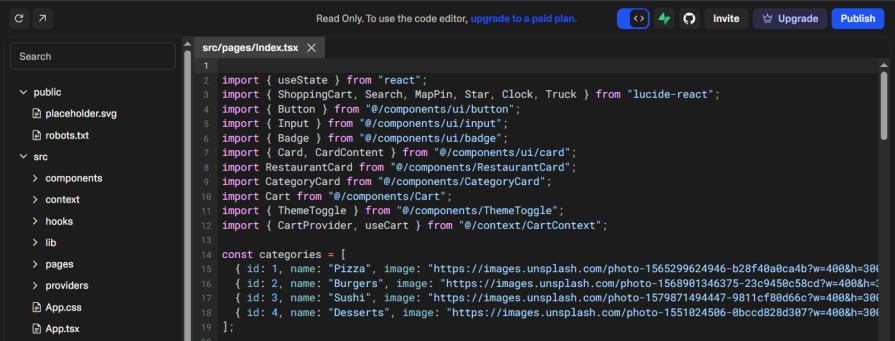
To publish your app in Lovable, you need to click on the publish button at the top right corner of the screen, add your custom domain, or stick to the Lovable subdomain if you are on the free plan
I have our test app here.
Unlike Lovable, Replit allows for generated code to be edited, even on the free tier.
To demonstrate, I will edit the text on the hero section of the app from “Delicious Food, Delivered Fast” to “Delicious Food, When you need it”:
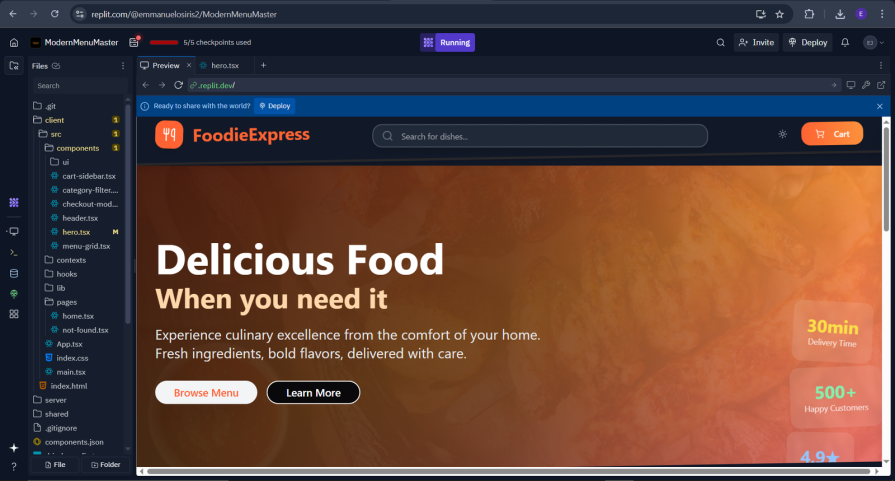
To deploy your app, you click on the Deploy button in the top right corner of the Replit environment.
From there, you can either stick with the AI-generated result or upgrade to a paid plan to choose your deployment plan.
Replit does a great job of fast deployment, but I prefer Firebase Studio code editor to any other because it uses VS Code web, which happens to be my favorite code editor.
In this section, I will look at creating a backend and data integration for our app.
I used a simple prompt of “Create a backend and connect it to the app. Also, handle the database.”
You will need to have a paid plan on Firebase Studio to be able to link your app backend to Firebase:
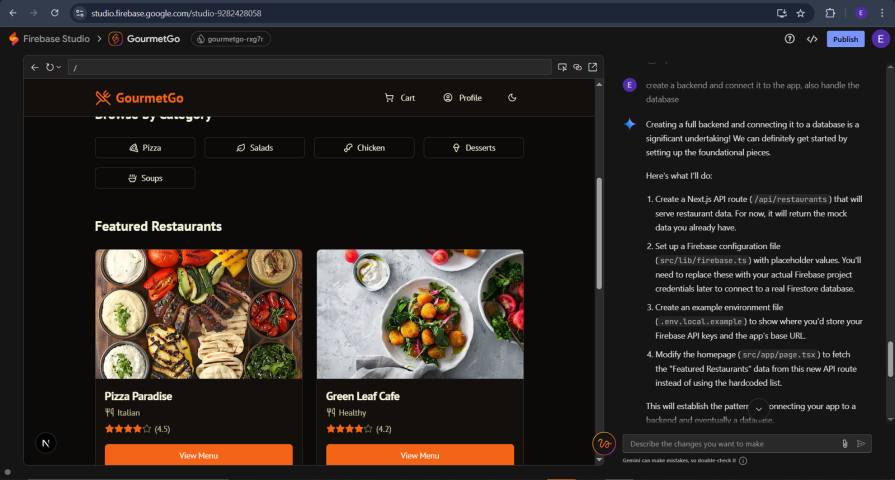
To create a backend on Lovable, you have to connect your Supabase account to the tool, followed by prompting the tool to create a backend for you.
You first click on the green button at the top right corner of the interface, then you follow the instructions to set up the interface:
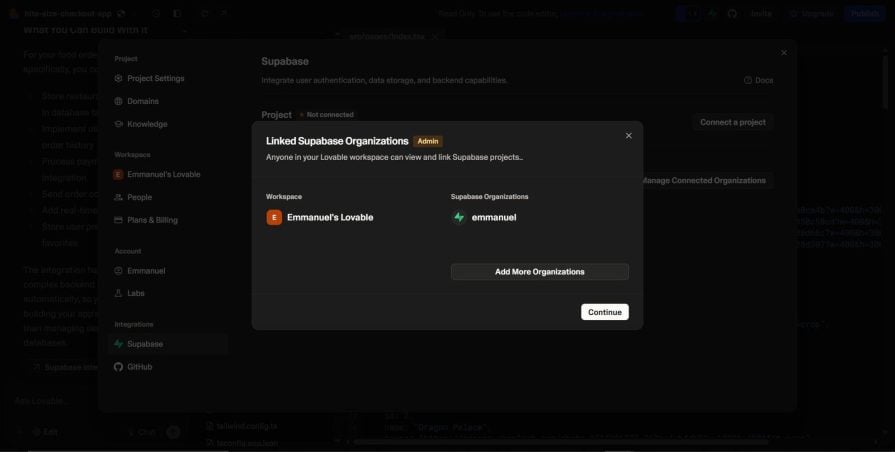
I then gave it the following prompt: “Create a backend and connect it to the app, also handle the database.”:
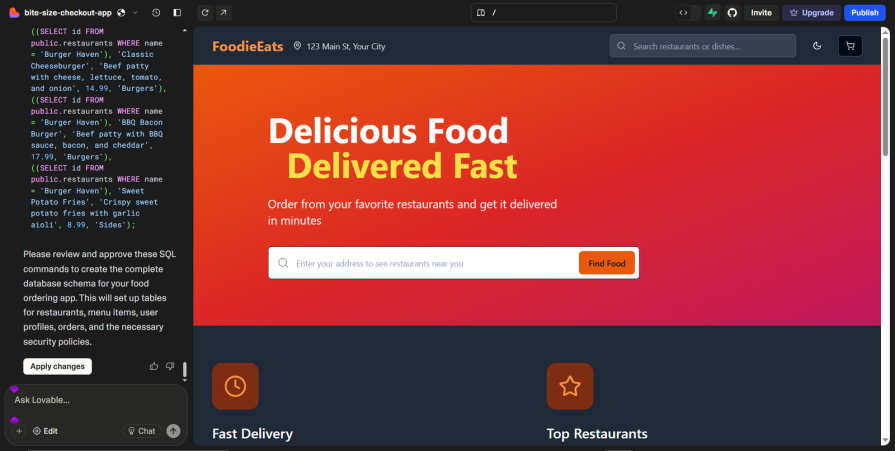
I clicked on apply changes, and it created a backend and a database for our app.
Creating a backend and setting up a database on Replit is easy and straight to the point.
With the “Create a backend and connect it to the app, also handle the database” prompt, Replit successfully:
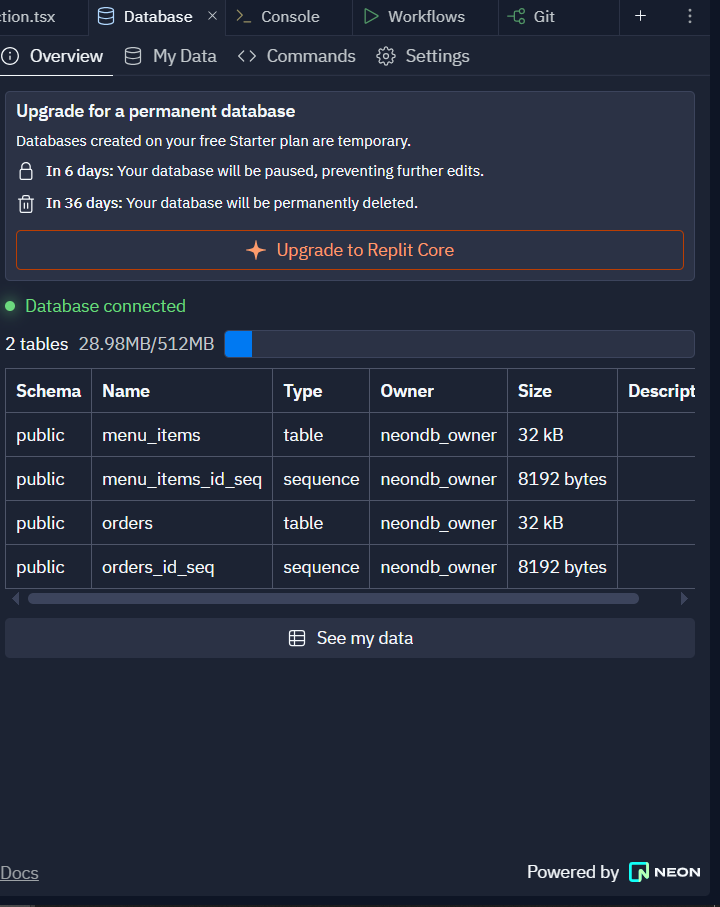
Replit is the winner. Backend and data integration can be done without stepping out of Replit, which makes life way easier.
Let’s see which of the AI app builders is perfect for collaboration.
If you have ever pushed code from your local machine to GitHub or any other remote-based git repository, then pushing code from Firebase Studio to GitHub wouldn’t be alien to you.
All it takes is to connect your GitHub to Lovable and sync your project two ways with GitHub to collaborate at the source.
You can also send an invite through email for someone to join the workspace.
At app creation, Replit creates a git repository that you can push to your favorite remote git repository.
It treats each prompt change the AI makes to your app as a commit message, which is nice:
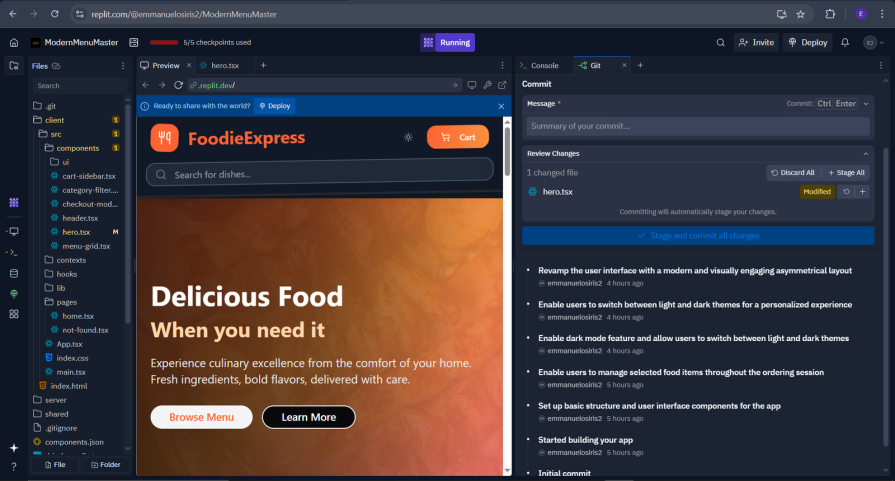
Replit supports collaboration, as you can send invites for other people to join the workspace and collaborate
Replit shines here as it uses major prompt changes as Git commit messages.
It also supports collaboration.
I will briefly go through the limitations of each platform.
If you are looking forward to collaborating on AI app building, Firebase Studio has no support for that. You can try the other options.
Though one of the best among the three, Replit takes the longest to generate code after prompt. It takes an average of 10 minutes. This might not be an issue, as it is still faster than coding yourself, and you can still ship quickly.
Lovable does not allow code editing if you are on the free plan. Also, if you use Lovable, be ready to be constrained to Subabase as your only choice of backend service.
AI-powered app builders have come to stay, and it’s important to evolve with the momentum.
In this tutorial, we compared the top three AI-powered app builders based on five metrics. We also covered their pros and cons and why you should choose one over the other in various situations.
If you are not conversant with software development, Replit is the tool for you. On the other hand, if you have a good level of experience in software development, then Firebase Studio and Lovable will be better choices.

Learn how to style React Native apps with Tailwind using NativeWind v4.
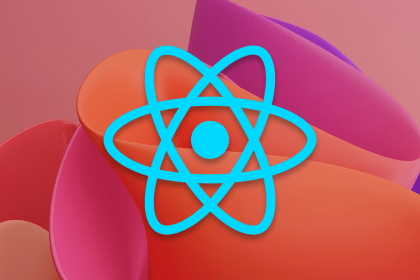
A practical guide to the best React Native UI libraries in 2026, with comparisons across performance, theming, accessibility, and Expo compatibility.
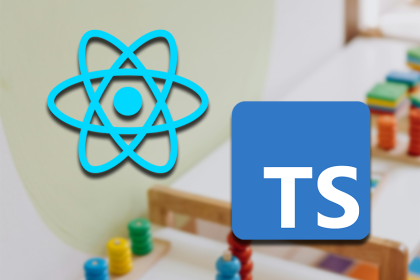
children correctly in TypeScriptLearn modern best practices for typing React children in TypeScript, including ReactNode, PropsWithChildren, ComponentProps, and why React.FC is no longer recommended.

Learn how to internationalize Next.js apps with Lingui and next-intl, covering App Router, RSC, routing, locale detection, and dynamic language switching.
Would you be interested in joining LogRocket's developer community?
Join LogRocket’s Content Advisory Board. You’ll help inform the type of content we create and get access to exclusive meetups, social accreditation, and swag.
Sign up now